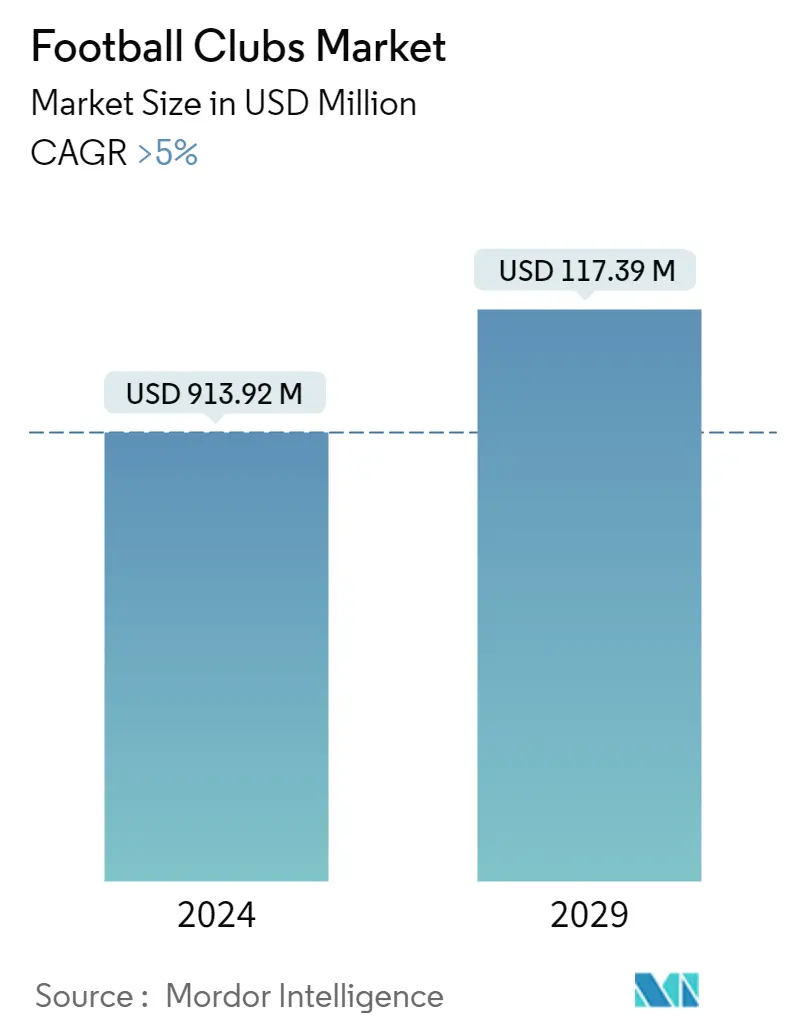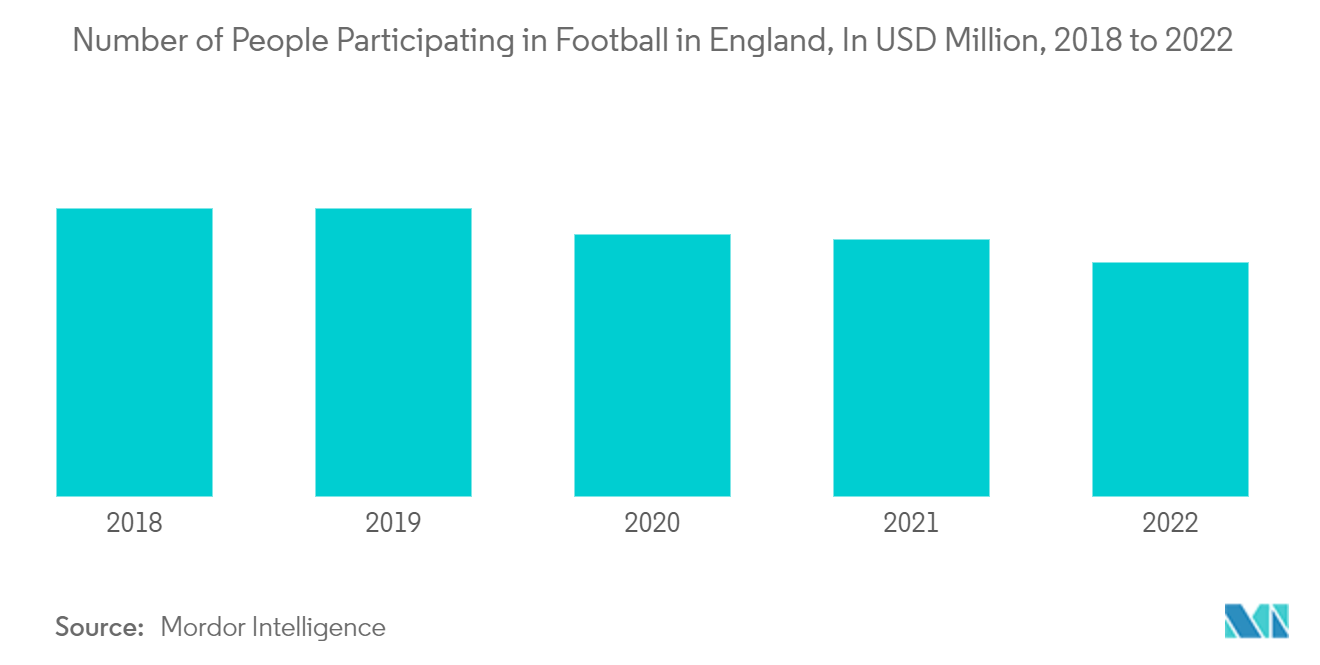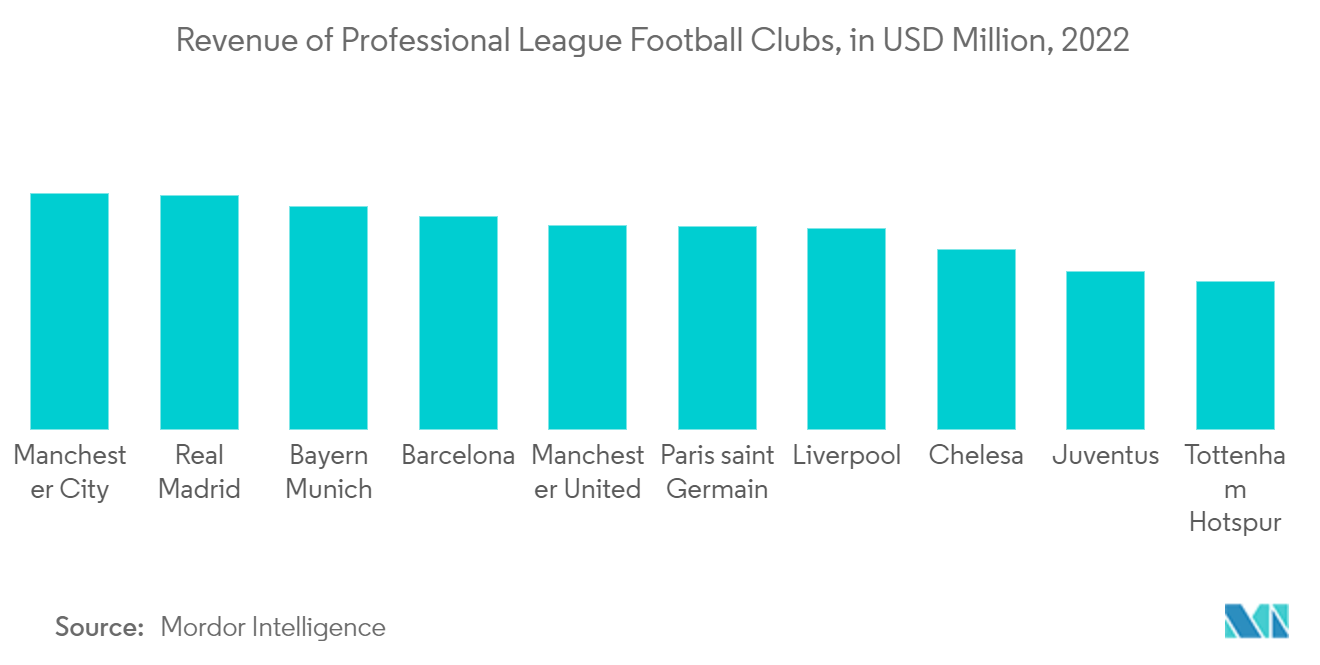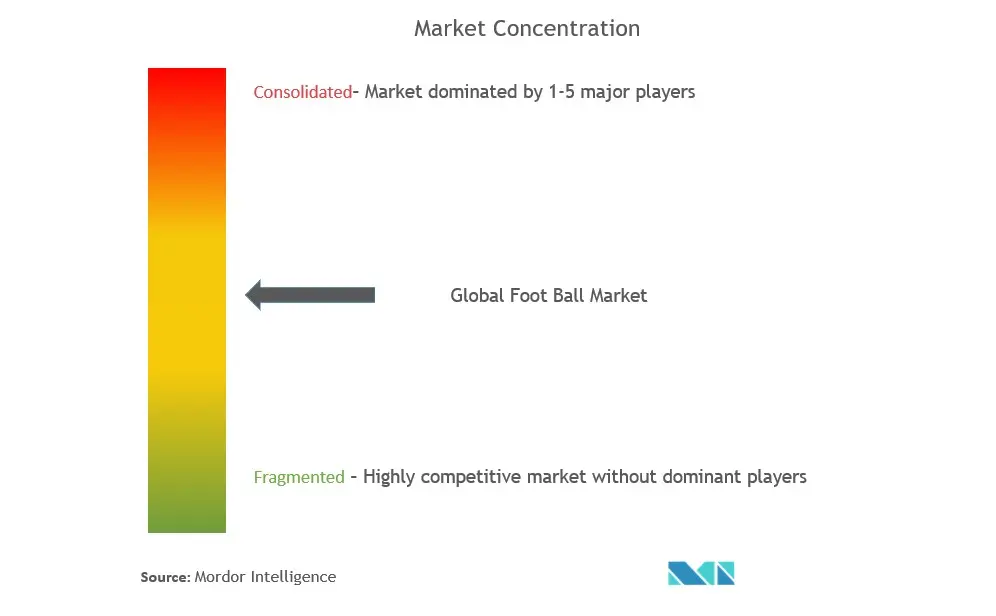Football Clubs Market Size

| Study Period | 2020 - 2029 |
| Base Year For Estimation | 2023 |
| Market Size (2024) | USD 913.92 Million |
| Market Size (2029) | USD 117.39 Million |
| CAGR (2024 - 2029) | 5.00 % |
| Market Concentration | Low |
Major Players.webp)
*Disclaimer: Major Players sorted in no particular order |
Football Clubs Market Analysis
The Football Clubs Market size is estimated at USD 913.92 million in 2024, and is expected to reach USD 117.39 million by 2029, growing at a CAGR of greater than 5% during the forecast period (2024-2029).
In 2022, North America accounted for the largest share of the football clubs market. The fastest-growing region is expected to be Africa. The market is poised to benefit from robust economic growth projected for a number of developed and developing economies.
In the current year, the total revenue of the top 20 revenue-generating clubs was a 13% increase reported by Money League clubs in the previous year and only marginally lower than reported before the COVID-19 pandemic. The rise in revenue was largely due to the return of fans, with matchday revenues rising from last year to the current year after two seasons affected by the pandemic.
In this unprecedented era of global sport, 2023 promises to provide organizations and athletes with more opportunities than ever before to engage deeply with their fan base. This includes taking part in some of the world’s most significant global sporting events, including the ICC World Cup in India, the Rugby World Cup in France, and the women’s FIFA World Cup in Australia and New Zealand. There will also be new media partnerships and more innovation from streaming services as they expand their reach.
Football clubs use social media and mobile apps to expand their reach and connect with fans in a more personal way. This has resulted in the development of new revenue sources, including digital advertising, online shopping, and streaming services.
Football Clubs Market Trends
Rising Active Participation in Football Leagues
The growing health consciousness among consumers is leading to the need to follow a healthier lifestyle. Consumers are engaged in several sports activities to maintain their health. The majority prefer outdoor games, such as football, as these outdoor sports activities require significant physical effort, thus enhancing the stamina levels of the players. Football also helps keep the body strong, flexible, and fit. It can also help avoid several health diseases and increase the mental stability of individuals. Therefore, being a complete workout package, the game is becoming popular among athletes, cricketers, and others. Moreover, government initiatives to promote football events are boosting people's interest in playing the sport, such as the FIFA World Cup in Qatar 2022 was set to boost people's interest in the country. Such factors are driving the sales of football worldwide.
Additionally, an independent identity, FIFA Foundation promotes football to accomplish its social responsibility through its various programs, such as Foundation Community Programme, Recovery Programme, FIFA Legends Programme, Football for Schools Programme, Campus Programme, Refugee Programme, and Employee Volunteer Programme. In the post-COVID-19 world, the FIFA Foundation is using football to help reconnect society, promote and support mental health awareness, and help empower and inspire people to participate in football for a healthy mind and body. This, in turn, is increasing the football participation rate across the globe and aiding the growth of the global football market.

Revenue From Football Club
A football club’s revenues can be broken down broadly into three overarching categories — commercial, broadcast, and matchday. While broadcast revenues are mostly dependent on the auction of TV rights, matchday revenues (ticket sales) are generally constrained by the capacity of a club’s stadium. Commercial revenues, therefore, become crucial for a club’s financial performance. However, over the past five years, broadcast revenues have increasingly become more important, primarily due to leagues striking lucrative TV deals and the increasing payouts by UEFA for teams competing in the Champions League. While commercial revenues are crucial, not all clubs have the ability to leverage their brand. Top clubs like Barcelona and Real Madrid have a massive international profile; therefore, they have great potential to raise money from merchandise sales, promotions, and sponsorship. Even among the top 20 clubs, there are wide disparities. For instance, Barcelona’s revenue from commercial operations is €20 million more than La Liga rival Atletico Madrid’s entire revenue for the 2018-19 season.

Football Clubs Industry Overview
The football clubs market is growing competitive. Football is a popular sport which is played globally. The increase in football club events at global and national levels influences the participation of players. Furthermore, this influence fuels the growth of the global football club market. Observing this response from the market, manufacturers are endeavoring to increase the quality and features of their products. The top five football clubs in the world are Real Madrid, Manchester United, Barcelona, Manchester City, and Liverpool.
Football Clubs Market Leaders
-
Real Madrid
-
Manchester United
-
Barcelona
-
Manchester City
-
Liverpool
*Disclaimer: Major Players sorted in no particular order

Football Clubs Market News
- September 2023: The Los Angeles Football Club announced the launch of LAFC Gold, a loyalty club designed to recognize LAFC’s most devoted supporters and fans with a host of unprecedented benefits. LAFC Gold is an innovative initiative that recognizes and acknowledges fans’ commitment to meaningful benefits and experiences, including merchandise discounts, partner promotions, premium experiences, and more, wherever they are around the globe.
- June 2022: PUMA, the global sports company, and Lega Serie launched a new football to mark the beginning of their partnership.
Football ClubsMarket Report - Table of Contents
1. INTRODUCTION
- 1.1 Study Assumptions and Market Definition
- 1.2 Scope of the Study
2. RESEARCH METHODOLOGY
3. EXECUTIVE SUMMARY
4. MARKET DYNAMICS AND INSIGHTS
- 4.1 Market Overview
-
4.2 Market Drivers
- 4.2.1 Active Participation
-
4.3 Market Restraints
- 4.3.1 Availability of Alternatives
-
4.4 Market Opportunities
- 4.4.1 Rising Active Participation in Football Leagues
- 4.5 Industry Value Chain Analysis
-
4.6 Industry Attractiveness - Porter's Five Forces Analysis
- 4.6.1 Bargaining Power of Suppliers
- 4.6.2 Bargaining Power of Buyers
- 4.6.3 Threat of New Entrants
- 4.6.4 Threat of Substitutes
- 4.6.5 Intensity of Competitive Rivalry
- 4.7 Insights on Key Trends and Recent Developments in the Market.
- 4.8 Impact of COVID-19 on the Market
5. MARKET SEGMENTATION
-
5.1 By Type
- 5.1.1 Ticket and Corporate Hospitality Sales
- 5.1.2 Television Relay Revenue Share
- 5.1.3 Sponsorship
- 5.1.4 Other Business Receipts
-
5.2 By Application
- 5.2.1 The Premier League
- 5.2.2 La Liga
- 5.2.3 Serie A
- 5.2.4 Bundesliga
- 5.2.5 Ligue 1
- 5.2.6 Other Clubs (Out of The Five League)
-
5.3 By Geography
- 5.3.1 North America
- 5.3.2 Europe
- 5.3.3 Asia-Pacific
- 5.3.4 Latin America
- 5.3.5 Middle East and Africa
6. COMPETITIVE LANDSCAPE
- 6.1 Market Concentration Overview
-
6.2 Company Profiles
- 6.2.1 Real Madrid
- 6.2.2 Manchester United
- 6.2.3 Barcelona
- 6.2.4 Manchester City
- 6.2.5 Liverpool
- 6.2.6 Bayern Munich
- 6.2.7 Chelsea
- 6.2.8 Arsenal
- 6.2.9 Juventus
- 6.2.10 Paris-Saint-German*
- *List Not Exhaustive
7. FUTURE OF THE MARKET
8. DISCLAIMER AND ABOUT US
** Subject To AvailablityFootball Clubs Industry Segmentation
In association football, a football club is a sports club that acts as an entity through which association football teams organize their sporting activities. The club can exist either as an independent unit or as part of a larger sports organization as a subsidiary of the parent club or organization.
The global football clubs market is segmented by type (ticket and corporate hospitality sales, television relay revenue share, sponsorship, and other business receipts), by application (the Premier League, La Liga, Serie A, Bundesliga, Ligue 1, other clubs (out of the five leagues), and by geography (North America, Europe, Asia-Pacific, Latin America, the Middle East, and Africa).
The report offers market size and forecasts for the global football clubs market in value (USD) for all the above segments.
| By Type | Ticket and Corporate Hospitality Sales |
| Television Relay Revenue Share | |
| Sponsorship | |
| Other Business Receipts | |
| By Application | The Premier League |
| La Liga | |
| Serie A | |
| Bundesliga | |
| Ligue 1 | |
| Other Clubs (Out of The Five League) | |
| By Geography | North America |
| Europe | |
| Asia-Pacific | |
| Latin America | |
| Middle East and Africa |
Football ClubsMarket Research FAQs
How big is the Football Clubs Market?
The Football Clubs Market size is expected to reach USD 913.92 million in 2024 and grow at a CAGR of greater than 5% to reach USD 117.39 million by 2029.
What is the current Football Clubs Market size?
In 2024, the Football Clubs Market size is expected to reach USD 913.92 million.
Who are the key players in Football Clubs Market?
Real Madrid, Manchester United, Barcelona, Manchester City and Liverpool are the major companies operating in the Football Clubs Market.
What years does this Football Clubs Market cover, and what was the market size in 2023?
In 2023, the Football Clubs Market size was estimated at USD 870.40 million. The report covers the Football Clubs Market historical market size for years: 2020, 2021, 2022 and 2023. The report also forecasts the Football Clubs Market size for years: 2024, 2025, 2026, 2027, 2028 and 2029.
Football ClubsIndustry Report
Statistics for the 2024 Football Clubs market share, size and revenue growth rate, created by Mordor Intelligence™ Industry Reports. Football Clubs analysis includes a market forecast outlook to for 2024 to 2029 and historical overview. Get a sample of this industry analysis as a free report PDF download.



